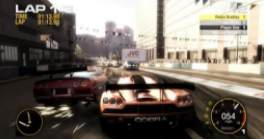Despite a loose relationship to the
classic Race Driver series, most players should probably approach Grid as
basically a new IP in terms of approach and style. Eschewing many of the
creaky conventions of the previous games, Grid is an edgier, and more
stylish racer that feels contemporary while offering the challenge and
depth that players have come to expect from Codemasters. However, instead
of feeling dry and mechanical, the immersive and engaging experience that
Grid creates is exciting and visceral, capturing the intensity of
real-world professional racing. Unlike other games that usually focus on a
specific style or approach to racing, Grid sets itself apart. The game
takes a wider-view of the genre, for a broad stroke approach to racing
including many different racing styles and disciplines. This gives players
plenty of challenges and techniques to master and broadens the selection
to include a huge array of vehicle types, styles and manufacturers. This
is all done with a cinematic approach featuring dramatic camera angles,
multiple racing views and slick production values. The expansive scope and
style makes playing Grid an incredibly intense experience. This means that
players can choose to race Formula One vehicles in European courses,
master drifting techniques in Asian competitions or battle against muscle
cars in
America
. These three distinct regions have their
own trophies and awards, which makes it almost like having multiple games
on one disc. Making the gameís design even better is its open-ended
structure that gives you many paths to try. These multiple branching paths
makes for a diverse and engaging title that offers plenty of variety and
different challenges and techniques to master, giving Grid a surprisingly
high replay value.
 Gridís
expansive design allows players to experience an impressive array of
disciplines and racing styles including Grip Racing, Touge battles,
Demolition Derby matches, Drifting and Endurance. Each racing style
requires a different skill-set and technique which should test each
driverís versatility and skill. Most races take place in packs, but
there are a number of head-to-head modes which are even more intense. Each
discipline also features different sub-categories of race, such as battle
drifting, up and down runs on the mountainous touge courses, drifting
points battles and many more variations. While there are many different
styles, the basic techniques of driving are fairly straightforward and
there are multiple control configurations available to suit your style. On
the road, players can choose from either in-car or outside viewpoints, all
of which give you a good look at the course. During each race, the cars
will take damage if they collide with other racers. Unlike many other
racing titles, Gridís damage system isnít cosmetic and actually
affects your racing performance, and can do so significantly. The amount
of damage is indicated on the lower right side of the screen and is
divided into five different categories, gears, suspension, engine,
steering and wheels. As each area degrades, so does your performance,
which means you need to avoid collisions in order to keep yourself
competitive. When youíve completely destroyed your car, you donít need
to worry. One of Gridís most technically impressive features is the
ability to use Instant Replays that rewind the action before your crash
point. The usefulness of these is obvious, giving you the ability to
replay sections of the track that were difficult or avoid another vehicle
you didnít see on your path. Itís quite simple to use this feature,
and it makes what would have been an otherwise extremely difficult title
easier to play. You only have a few of these for each race, and fewer
still at the higher difficulty settings. This makes Instant Replay a
useful crutch, but not one that you can rely on indefinitely.
Gridís
expansive design allows players to experience an impressive array of
disciplines and racing styles including Grip Racing, Touge battles,
Demolition Derby matches, Drifting and Endurance. Each racing style
requires a different skill-set and technique which should test each
driverís versatility and skill. Most races take place in packs, but
there are a number of head-to-head modes which are even more intense. Each
discipline also features different sub-categories of race, such as battle
drifting, up and down runs on the mountainous touge courses, drifting
points battles and many more variations. While there are many different
styles, the basic techniques of driving are fairly straightforward and
there are multiple control configurations available to suit your style. On
the road, players can choose from either in-car or outside viewpoints, all
of which give you a good look at the course. During each race, the cars
will take damage if they collide with other racers. Unlike many other
racing titles, Gridís damage system isnít cosmetic and actually
affects your racing performance, and can do so significantly. The amount
of damage is indicated on the lower right side of the screen and is
divided into five different categories, gears, suspension, engine,
steering and wheels. As each area degrades, so does your performance,
which means you need to avoid collisions in order to keep yourself
competitive. When youíve completely destroyed your car, you donít need
to worry. One of Gridís most technically impressive features is the
ability to use Instant Replays that rewind the action before your crash
point. The usefulness of these is obvious, giving you the ability to
replay sections of the track that were difficult or avoid another vehicle
you didnít see on your path. Itís quite simple to use this feature,
and it makes what would have been an otherwise extremely difficult title
easier to play. You only have a few of these for each race, and fewer
still at the higher difficulty settings. This makes Instant Replay a
useful crutch, but not one that you can rely on indefinitely.
The
gameís open-ended structure allows players to progress at their own
pace, beginning with the Race Day mode where you can set up and race
individual rounds which help you to get the feel of the road. Once
youíve gotten past these highly enjoyable, arcade-style races you can
delve deeper into the game with its Grid World mode. Here, you are put in
charge of your own racing team and begin with a single vehicle. As you win
races, youíll earn money and increase your reputation. Earning money
allows you to purchase additional vehicles, while the reputation gives you
additional invitations to special events. While things start off slowly in
this mode, your gradual progress allows you to see more of the gameís
exotic and high-powered vehicles. While youíre building your racing
team, you can earn additional money by racing for other teams and
completing objectives and tasks specific to each race. Thereís quite a
broad selection of racing styles and vehicles to choose from, and these
depend on which region you decide to focus on. For example, in the
Japanese races, the emphasis is mostly on style with many drifting races
to beat, along with more traditional racing. Once youíve garnered enough
money and acclaim, youíll be invited to race in huge events such as the
Lemans 24 Hour endurance race, where you can truly test your skills. Grid
World is an incredibly deep mode of play, and one that requires a great
deal of persistence to beat.
 Players
will find a huge variety of courses in the game including street courses,
back alleys, shipyards, traditional racing tracks in a variety of
locations including Detroit, London, Tokyo, Donington and Nuremburg to
name a few. Thereís a remarkable level of detail in these tracks and the
smooth frame rate makes each stage look beautiful and realistic. Players
can choose from multiple viewpoints on the fly, but the in-car mode is
particularly impressive. Light sourcing, reflection, shadows plus day and
night racing makes the game even better visually. The engineís damage
system is also impressive, and players can watch each crash in detail
thanks to the extensive replay system. Gridís huge inventory of vehicles
includes everything from muscle cars, to standard road vehicles, concept
vehicles and open-wheeled racing machines. These come from a variety of
racing manufacturers including GM, Aston Martin, Porsche, Toyota, Audi,
BMW and Nissan along with a huge selection lesser-known boutique brands
like Top Secret, Pagani Atomobili, Alan Docking, Team Orange and TXR to
name just a few. Adding to the authenticity, real life parts manufacturers
and sponsors also appear in the game. One of the more interesting results
allows players to purchase slightly used vehicles from eBay Motors,
instead of a generic shop, which is fairly interesting. Using real-life
manufacturers adds to Gridís realism while allowing for a great deal of
variety. In terms of performance and style, Grid has a diversity in racing
styles and approaches thatís quite impressive and makes playing through
a more engaging experience.
Players
will find a huge variety of courses in the game including street courses,
back alleys, shipyards, traditional racing tracks in a variety of
locations including Detroit, London, Tokyo, Donington and Nuremburg to
name a few. Thereís a remarkable level of detail in these tracks and the
smooth frame rate makes each stage look beautiful and realistic. Players
can choose from multiple viewpoints on the fly, but the in-car mode is
particularly impressive. Light sourcing, reflection, shadows plus day and
night racing makes the game even better visually. The engineís damage
system is also impressive, and players can watch each crash in detail
thanks to the extensive replay system. Gridís huge inventory of vehicles
includes everything from muscle cars, to standard road vehicles, concept
vehicles and open-wheeled racing machines. These come from a variety of
racing manufacturers including GM, Aston Martin, Porsche, Toyota, Audi,
BMW and Nissan along with a huge selection lesser-known boutique brands
like Top Secret, Pagani Atomobili, Alan Docking, Team Orange and TXR to
name just a few. Adding to the authenticity, real life parts manufacturers
and sponsors also appear in the game. One of the more interesting results
allows players to purchase slightly used vehicles from eBay Motors,
instead of a generic shop, which is fairly interesting. Using real-life
manufacturers adds to Gridís realism while allowing for a great deal of
variety. In terms of performance and style, Grid has a diversity in racing
styles and approaches thatís quite impressive and makes playing through
a more engaging experience.
Gridís
slick production values extend off the track into its beautifully designed
menu system. Instead of a few static screens here and there, players are
treated to full blown
CGI
renderings
of their status, such as laps driven, highest drift score and favorite
racing type. This gives the game an even deeper polish and helps to
immerse you even further into the game. While many titles offer players
the chance to use their own name, Grid takes this approach a step further
by implementing a speech system, where players can enter their name and
then hear the announcers drop it into the usual speech. It can be a bit
jarring initially gives the game a more personal touch. As stated earlier,
the graphics engine looks incredibly slick on the road, though some of the
bleached-color effects can become distracting after awhile. Gridís sharp
AI makes things realistic on the road, with very aggressive and near
flawless rivals giving players very little room for error. This can make
for an occasionally frustrating experience, though nothing that a little
practice and persistence canít fix. Overall, Gridís huge selection of
vehicles, racing disciplines, styles and approaches gives it plenty of
depth, while its accessible controls allow players to jump right in
without spending hours mastering its nuances. The gameís slick
production values, challenging AI and varied gameplay make Grid one of
deepest and most satisfying racing titles, making Grid another solid racer
from Codemasters.
- Michael Palisano

